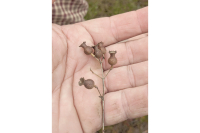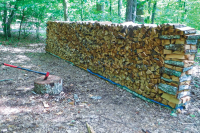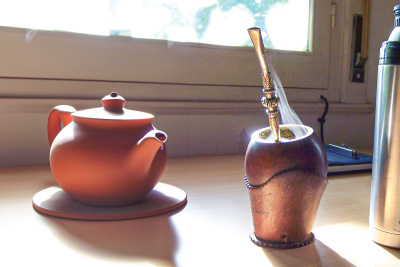Hunting for kudzu
Even as I parked my car at the bottom of a steep and weedy hill that Friday morning, I wasn’t quite sure what I’d signed up for by electing to participate in Kudzu Camp.
Colorful reminders of long-ago homesteads
A chimney standing all alone where a fire burned a house down long ago … a crumbling stone wall overgrown with tangles of vines … a flattened area on a slope above a creek or abandoned roadbed … all are likely locations for a dwelling or outbuilding of some sort.
A diverse portfolio: Seed bank works to protect genes of WNC plants
It’s been just about 10 years since the day Joe-Ann McCoy, then living in Iowa and working as the national medicinal plant curator for the U.S. Department of Agriculture, got a life-changing call from her home region of Western North Carolina.
It was the N.C. Arboretum in Asheville, and they wanted to know if she’d be interested in trading her secure government job for a position funded by grants and contracts, moving to the Asheville area, and starting up a seed bank.
The Naturalist's Corner: Bamboo by any other name
Bamboo is the common name applied to a wide and varied group of woody grasses from all around the world. There are more than 1,000 species of bamboo. Bamboo grows in temperate and tropical climates in the Americas and throughout Asia with the greatest diversity occurring in tropical areas.
Time to enjoy the bounty of your flower garden
[Before moving on to the primary subject of this column (yard gardens), I’d like to share some impressions with you of the eclipse, which (as I’m writing this) took place yesterday. For several weeks before the celestial event (as I grew weary of all the commercial hoopla), I shifted into my “Bah-humbug” mode. When asked where I was going to watch it from, I’d roll my eyes and announce: “My bedroom … it’ll be a good time to take a nice nap.”
Cherokee had uses for many local plants
For the ancient Cherokees and other southeastern Indian tribes, the greatest causes of illness were the spirits of vengeful animals. They were so angered at the killing of their brethren by hunters they convened a great council and devised human illnesses as payback.
Sylva’s carnivorous plant man: After nearly 30 years and thousands of plants, carnivorous plants still fascinate
When it comes to carnivorous plants, Darwin Thomas knows what he’s talking about. It doesn’t take much to get him started on a fact-filled tangent about the plants’ prey preferences, proper care and feeding, or histories. But Thomas, a heating and air technician by trade, didn’t learn any of it by sitting in a class somewhere.
“I read a lot of books, and just talking to people too,” Thomas said. “I’ve not had any education at all in anything to do with this. I just learned over the years. And after 28 years, I think I’ve learned how to grow them.”
Moonshine stills weren’t the only stills
All this spring, golden birch catkins were dangling throughout the woodlands of the Smokies region. These are the male, pollen-carrying part of the sweet birch (Betula lenta), also known as black, cherry, or mahogany birch.
The Naturalist's Corner: Is spring springing earlier?
Back in January I surveyed the Tellico Fire with MountainTrue biologist Josh Kelly. We were there to check out the intensity and severity of the fire. The date was January 19 and we found a few Hepatica acutiloba (sharp-lobed hepatica) in flower. Kelly said that was the earliest he had ever seen it in flower.
Witch-hazel has adapted as a late flowering plant
Editor’s note: this article first appeared in a November 2003 edition of The Smoky Mountain News.
If you take a walk along a woodland edge within the next few weeks, there’s every chance you’ll discover witch-hazel in full bloom. It sometimes flowers by early September and will persist into late December or early January during warm winters. But from early October into early November is the time to catch witch-hazel in its prime.









